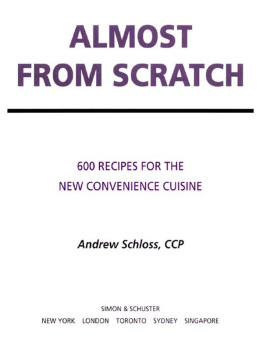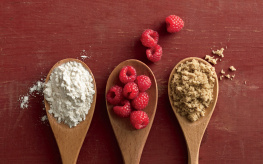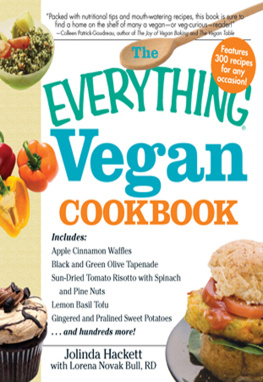

B. Smith Cooks
Southern-Style
Barbara Smith


SCRIBNER
A Division of Simon & Schuster, Inc.
1230 Avenue of the Americas
New York, NY 10020
www.SimonandSchuster.com
Copyright 2009 by Barbara Smith
All rights reserved, including the right to reproduce this book or portions thereof in any form whatsoever.
For information address Scribner Subsidiary Rights Department, 1230 Avenue of the Americas, New York, NY 10020
First Scribner hardcover edition November 2009
SCRIBNER and design are registered trademarks of The Gale Group, Inc.
used under license by Simon & Schuster, Inc., the publisher of this work.
For information about special discounts for bulk purchases, please contact Simon & Schuster Special Sales at 1-866-506-1949 or business@simonandschuster.com.
The Simon & Schuster Speakers Bureau can bring authors to your live event. For more information or to book an event contact the Simon & Schuster Speakers Bureau at 1-866-248-3049 or visit our website at www.simonspeakers.com .
DESIGNED BY ERICH HOBBING
Manufactured in the United States of America
10 9 8 7 6 5 4 3 2 1
Library of Congress Control Number: 2009021070
ISBN 978-1-4165-5354-0
ISBN 978-1-4165-9543-4 (ebook)
This book is dedicated to my father,
William H. Smith,
who loved, inspired and taught me
an appreciation for the finer things in life.
Contents
B. Smith Cooks Southern-Style
Introduction
Why a Southern Cookbook Now?
Are you from the South? Through the years, I think Ive been asked that question as much as, How are you?
No, Im not from the South but Im from southwestern Pennsylvania, I answer, always with conviction and a smile. My family ended up in southwestern Pennsylvania by way of North Carolina and Virginia, where the first enslaved Africans arrived. Like many families, ours boasted strong Southern roots, and nowhere was it more evident than in my mothers, grandmothers, and aunts pots and pans.
While researching this book and the heritage of Southern cooking, I discovered that theres more Southern in me than Id realized. Eastern West Virginia borders southwestern Pennsylvania, and along with that border we also share a culture. Growing up, I never differentiated between Northern and Southern cooking; all I knew was the food we ate, and it wasnt goodit was great. My mother cooked like our neighbors cooked. I thought people all over the country ate the way we did. I didnt know the difference until I traveled north to the other side of Pittsburgh. Thats where I saw for the first time cornbread inside a turkey, instead of inside my mothers iron skillet!
When I started modeling and traveling with the Ebony Fashion Fair, I was lucky to be able to explore different kinds of foods. But when I was back in New York, it had to be Southern. Trips to the Horn of Plenty, The Pink Tea Cup, Sylvias, and Wells for its famous chicken and waffles were musts. It wasnt easy staying model thin savoring a plate of smothered chicken, but over time I learned how to enjoy the food I loved by eating in moderation. I had to choose between my taste buds and my budding career.
Ive always had more than a sprinkling of Southern dishes on my restaurants menus. At the first B. Smiths in New York, it was a tradition to have chitlins on the New Years Eve menu. It brought back memories of my mother preparing chitlins all day to make sure they were ready and right for the New Year. B. Smiths New York wasnt a soul food restaurant, but the funny thing about Southern food is that you put a couple of those kinds of dishes on the menu and people anoint it Southern. My goal was to always keep it eclectic. I like to think of the Southern dishes we served as inspired cooking. B. Smiths in Washington, D.C. was a different story. Since it was in the South, I had to have a great Southern chef, and I found him with the help of the famous Louisiana chef Paul Prudhomme.
Southern cuisine is bigger than crispy fried chicken and collard greens. Its a culturally rich and diverse cuisine with history in its ingredients, flavors, and textures. I like to look at it as a cultural artifact of the Old South. Theres nothing like it. What other cuisine has had its journey? New settlers, enslaved Africans, enslavers, and Native Americans all had a stake in it.
In the world of food, I consider myself an explorer inside and outside the kitchen. I learn something from every bite, whether I prepared it or not. What better way to satisfy ones curiosity than with food?
I learned that the seductive flavors of Louisiana Creole cuisine have roots in France. I learned that Cajun gets its lively and spicy reputation from traditional African cooking. I respect the Upper Souths penchant for pork and knowing what to do with it as much as I respect and love the Low Countrys skill with seafood and various combinations.
Contrary to popular thought, enslaved Africans didnt bring their favorite foods with them. Slavery wasnt nice that way. Along with their human cargo, enslavers transported seeds to grow fruits and vegetables, like watermelon and okra. Once on land, enslaved Africans cultivated the land and planted the seeds.
And Native Americans brought a whole lot more than corn to the table. Thanks to them, early settlers meals became more interesting and flavorful with a variety of squashes, tomatoes, and all kinds of beans, peppers, and fruits.
The big American Southern breakfast was attributed to the British fry-up, a meal heavy on pork, eggs, fried bread, and potatoes. The settlers were big hunters and didnt discriminate when it came to eating various parts of an animal, such as organ meats that included intestines, or chitterlings. Contrary to popular belief, whites, blacks, and Native Americans ate a lot of the same foods. What was different were the conditions under which they ate them. When you put all of this history together in a big pot, we call that Southern cuisine.
What I wanted to do with the recipes in this book was to bring modern eating to an old-school cuisine. Southern cooking with its rich and sometimes fat-laden qualities hasnt withstood the test of time with the health food movement. Today its more about eating whats better for you than just what tastes good. I believe that we can have our Southern food and eat it too, with all the flavor we want and without the fat we dont need.
Let me get something straight: I like fat. It adds flavor like no other ingredient Ive ever come across in all of my experience cooking. What Ive done is lighten up the traditional Southern dishes we love by revisiting their original recipes, unlocking old secrets to perfect taste, and creating new ones. Talk about new ideasanyone for Alligator Sausage Patties? We cant seem to make enough Braised Black-Eyed Peas and Greens for the restaurants; now you can make all you want in your own home. Learn my secret to how I cut down the fat when I make chitterlings; you wont be disappointed. (My husband, Dan, put a hurtin on them.) Theres a whole section on sauces and gravies, recipes so delectable its a pity they have to go on top of something.
I love Southern food. I love the way it blankets me in comfort. I love the warm and loving memories it evokes. And theres nothing like seeing Dan and our daughter, Dana, light up when something Southern is on the table. It makes me the happiest gal from southwestern Pennsylvania.
Next page


















